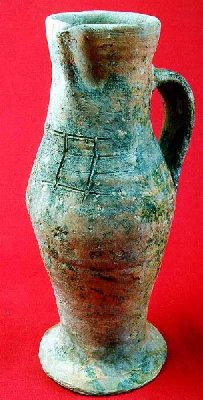|
|
Biconical Jug from Oxford: 14th century |

Jugs had changed shape by the 14th century, from the globular, capacious forms suitable for holding a gallon or so of ale, to taller, narrower, more elegant shapes which probably reflect a greater preference for wine.
This sparsely glazed ceramic jug was found in St Frideswide’s Monastery (the present college of Christ Church). Perhaps the curious mark was incised on the body to designate the jug and contents as belonging to the monastery’s cellars and buttery, or drinks servery, like the bottle seals on post-Medieval college wine bottles of glass. The mark itself is in a Medieval style resembling masons’ marks on Medieval stone buildings, and reminds us that literacy was not widespread at this time.
© 1998 Oxfordshire Museum Service, Setúbal Museums and the Benaki Museum